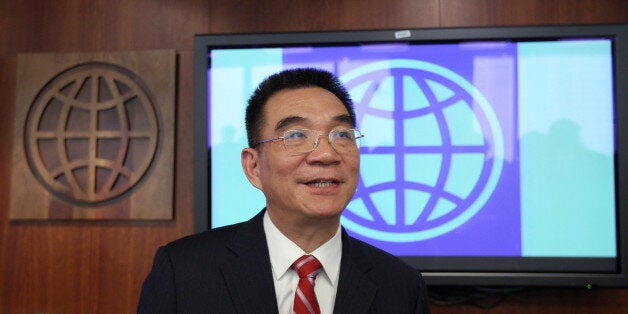

Lin Yifu is the former Chief Economist and Senior Vice President of the World Bank. This article was translated from the Chinese original published in the journal Guancha (www.guancha.cn).
BEIJING -- The Third Plenum of the Chinese Communist Party's 18th Congress took place in November 2013 amid widespread calls for drastic economic reforms. Many analysts and commentators claim that the Chinese economy is stalling because of systemic problems and, therefore, nothing short of fundamental structural changes can save it from a precipitous downward spiral in growth rate.
Furthermore, many have suggested, slowing growth will exacerbate social problems such as the wealth gap and lead to political instability.
They are misjudging the state of the Chinese economy and its trajectory. China is actually on course to achieving 8 percent annual GDP growth for the next 10 to 15 years or longer. The sweeping economic reform agenda announced at the recent plenum was designed to further propel this growth and cover potential downside risks, not to save the economy from impending catastrophe.
To be sure, the growth rate has been slowing significantly in recent months. Since the first quarter of 2010, growth has been decelerating for 13 straight quarters from near double digits to 7.5 percent in the second quarter 2013. This has been the most sustained period of deceleration in growth since the start of economic reforms in 1979. However, the underlying causes for this slowdown are global, not China specific.
A survey of emerging economies around the world could help clarify the picture. Brazil saw its growth rate drop from 7.5 percent in 2010 to 2.7 percent in 2011 and 0.9 percent in 2012. During the same period, India's growth rate went from 10.5 percent to 6.3 percent and 2.2 percent; South Korea from 6.3 percent to 3.7 percent and 2.0 percent; Taiwan from 10.7 percent to 4.1 percent and 1.3 percent; and Singapore from 10.8 percent to 5.0 percent and 1.3 percent. Pressured by the same global downward forces, China actually did not fare as badly, its growth rate dropping from 10.4 percent to 9.3 percent and 7.8 percent.
No country can sustain a double-digit growth rate indefinitely. China has done so for the past two decades -- a very long stretch by any standard. There are strong reasons to believe the Chinese economy, on its current course, can still deliver a high single-digit growth rate for another generation.
As a developing country, China has sufficient room to continue to use its gap with developed countries to drive its economic growth in the foreseeable future.
As a general rule, developing economies can take advantage of mature technologies and industrial practices in rich nations to generate high growth at lower costs and risks compared to developed economies. Post World War II, 13 such economies achieved higher than a 7 percent annual growth rate for longer than 25 years, of which China is no doubt the largest. Some say that China has already exhausted the potential of this model of development. But such an assessment is incorrect.
The gap in technology and industrial value-add can be measured by average labor productivity, which is in turn best reflected in average income per capita. According to data compiled by economist Angus Maddison, in 2008, China's per capita income measured by purchasing power parity (PPT) was only 21 percent that of the United States'. This gap was equivalent to that between the U.S. and Japan in 1951, Singapore in 1967, Taiwan in 1975, and South Korea in 1977. Driven by this gap, all of these countries grew by high single-digit growth for more than two decades.
The first phase of China's catch-up game took the country from income per capita of U.S. $154 in 1978, only one third of an average African country at that time, to U.S. $6,100 in 2012 -- a higher middle-income country. But it is still at the level of the likes of Japan and South Korea decades ago. China can continue to take advantage of this gap to grow at an approximately 8 percent annual rate for one to two decades.
China's healthy fiscal conditions provide further assurances. Many media reports of late have sounded dire warnings about overleverage, particularly by local governments. No doubt, problems exist. But such concerns are often overstated.
Chinese central government's debt is at 14.9 percent of GDP. Local government debts total 10 trillion RMB -- 19.2 percent of GDP. Even the most pessimistic estimates put local government debts at total of 17 trillion RMB. So, combined government debts are at 34.7 percent to 47.6 percent of GDP.
In comparison, Japan is at 240 percent. Most developed countries debts are above 100 percent of GDP. Furthermore, most nations' debts is used largely to finance consumption and is, in other words, real borrowings. A vast majority of China's government debts are used to finance investments in infrastructure. The two are qualitatively different.
On top of that, the government also has 3.7 trillion U.S. dollars in its foreign reserve coffer. In addition to the government's strong fiscal position, China's personal savings rate is over 50 percent of GDP, among the highest in the world. With this balance sheet, China's ability to implement counter cyclical measures in times of need is exceptionally strong.
The Third Plenum announced aggressive economic reform initiatives. The market will continue to increase its role in resource allocations. The private sector will be given more room to grow and compete. The financial sector will be liberalized.
This growth enabled by these reforms will be substantially higher than the 6.8 percent required to reach the government's goal of doubling income per capita by 2020, leading China to join the ranks of high-income nations.
Post World War II, only two economies, South Korea and Taiwan, have managed to leap from low-income to high-income status. Since China is many times bigger, that would be an extraordinary accomplishment indeed.
